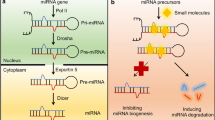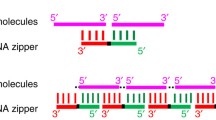ABSTRACT
Purpose
Cataloguing endogenous miRNA targets by inhibiting miRNA function is fundamental to understanding the biological importance of each miRNA in gene regulatory pathways. Methods to down-regulate miRNA activity may help treat diseases where over-expression of miRNAs relates to the underlying pathophysiology. This study objectively evaluates the in vitro potency of different anti-miRNA oligonucleotides (AMOs) using various design and modification strategies described in the literature as well as some novel modification strategies.
Methods
MiR21 and miR16 AMOs, containing chemical modifications such as 2′-O-methyl RNA, locked nucleic acid and 2′-Fluoro bases with or without phosphorothioate linkages, were directly compared by transfection into HeLa cells using a dual-luciferase reporter assay to quantify miRNA inhibition.
Results
Potency for the various AMOs ranged from inactive at high dose (50 nM) to strongly inhibitory at both high and low dose (1 nM). Including phosphorothioate linkages improved nuclease stability and generally increased functional potency.
Conclusions
Incorporating high binding affinity modifications, such as LNA and 2′F bases, increases AMO potency while maintaining specificity; nevertheless, use of low dose is preferred when using high potency reagents to minimize the potential for cross reactivity. 2′OMe/LNA chimeras with PS modifications were the most potent constructs tested for miRNA inhibition in vitro.





Similar content being viewed by others
Abbreviations
- 2′F:
-
2′-F RNA
- 2′OMe:
-
2′-O-methyl RNA
- AMO:
-
anti-miRNA oligonucleotide
- ASO:
-
antisense oligonucleotide
- LNA:
-
locked nucleic acids
- miRNA:
-
microRNA
- RISC:
-
RNA induced silencing complex
- RNAi:
-
RNA interference
- Tm:
-
melting temperature
- UTR:
-
untranslated region
REFERENCES
Carthew RW, Sontheimer EJ. Origins and mechanisms of miRNAs and siRNAs. Cell. 2009;136:642–55.
Vaucheret H. Post-transcriptional small RNA pathways in plants: mechanisms and regulations. Genes Dev. 2006;20:759–71.
Lewis BP, Burge CB, Bartel DP. Conserved seed pairing, often flanked by adenosines, indicates that thousands of human genes are microRNA targets. Cell. 2005;120:15–20.
Krek A, Grun D, Poy MN, Wolf R, Rosenberg L, Epstein EJ et al. Combinatorial microRNA target predictions. Nat Genet. 2005;37:495–500.
Alvarez-Garcia I, Miska EA. MicroRNA functions in animal development and human disease. Development. 2005;132:4653–62.
Johnston RJ, Hobert O. A microRNA controlling left/right neuronal asymmetry in Caenorhabditis elegans. Nature. 2003;426:845–9.
Wilfred BR, Wang WX, Nelson PT. Energizing miRNA research: a review of the role of miRNAs in lipid metabolism, with a prediction that miR-103/107 regulates human metabolic pathways. Mol Genet Metab. 2007;91:209–17.
Lindsay MA. microRNAs and the immune response. Trends Immunol. 2008;29:343–51.
Nelson PT, Wang WX, Rajeev BW. MicroRNAs (miRNAs) in neurodegenerative diseases. Brain Pathol. 2008;18:130–8.
Bushati N, Cohen SM. MicroRNAs in neurodegeneration. Curr Opin Neurobiol. 2008;18:292–6.
Thum T, Catalucci D, Bauersachs J. MicroRNAs: novel regulators in cardiac development and disease. Cardiovasc Res. 2008;79:562–70.
Xiao C, Rajewsky K. MicroRNA control in the immune system: basic principles. Cell. 2009;136:26–36.
Esquela-Kerscher A, Slack FJ. Oncomirs—microRNAs with a role in cancer. Nat Rev Cancer. 2006;6:259–69.
Wiemer EA. The role of microRNAs in cancer: no small matter. Eur J Cancer. 2007;43:1529–44.
Croce CM. Causes and consequences of microRNA dysregulation in cancer. Nat Rev Genet. 2009;10:704–14.
Lee Y, Ahn C, Han J, Choi H, Kim J, Yim J et al. The nuclear RNase III Drosha initiates microRNA processing. Nature. 2003;425:415–9.
Lund E, Guttinger S, Calado A, Dahlberg JE, Kutay U. Nuclear export of microRNA precursors. Science. 2004;303:95–8.
Schaefer A, O’Carroll D, Tan CL, Hillman D, Sugimori M, Llinas R et al. Cerebellar neurodegeneration in the absence of microRNAs. J Exp Med. 2007;204:1553–8.
Cai X, Hagedorn CH, Cullen BR. Human microRNAs are processed from capped, polyadenylated transcripts that can also function as mRNAs. RNA. 2004;10:1957–66.
Krutzfeldt J, Rajewsky N, Braich R, Rajeev KG, Tuschl T, Manoharan M et al. Silencing of microRNAs in vivo with ‘antagomirs’. Nature. 2005;438:685–9.
Davis S, Lollo B, Freier S, Esau C. Improved targeting of miRNA with antisense oligonucleotides. Nucleic Acids Res. 2006;34:2294–304.
Lennox KA, Sabel JL, Johnson MJ, Moreira BG, Fletcher CA, Rose SD et al. Characterization of modified antisense oligonucleotides in Xenopus laevis embryos. Oligonucleotides. 2006;16:26–42.
Brown DA, Kang SH, Gryaznov SM, DeDionisio L, Heidenreich O, Sullivan S et al. Effect of phosphorothioate modification of oligodeoxynucleotides on specific protein binding. J Biol Chem. 1994;269:26801–5.
Geary RS, Watanabe TA, Truong L, Freier S, Lesnik EA, Sioufi NB et al. Pharmacokinetic properties of 2′-O-(2-methoxyethyl)-modified oligonucleotide analogs in rats. J Pharmacol Exp Ther. 2001;296:890–7.
Freier SM, Altmann KH. The ups and downs of nucleic acid duplex stability: structure-stability studies on chemically-modified DNA:RNA duplexes. Nucleic Acids Res. 1997;25:4429–43.
Petersen M, Bondensgaard K, Wengel J, Jacobsen JP. Locked nucleic acid (LNA) recognition of RNA: NMR solution structures of LNA:RNA hybrids. J Am Chem Soc. 2002;124:5974–82.
Kurreck J, Wyszko E, Gillen C, Erdmann VA. Design of antisense oligonucleotides stabilized by locked nucleic acids. Nucleic Acids Res. 2002;30:1911–8.
Crinelli R, Bianchi M, Gentilini L, Magnani M. Design and characterization of decoy oligonucleotides containing locked nucleic acids. Nucleic Acids Res. 2002;30:2435–43.
Frieden M, Hansen HF, Koch T. Nuclease stability of LNA oligonucleotides and LNA-DNA chimeras. Nucleos Nucleot Nucleic Acids. 2003;22:1041–3.
Petersen M, Wengel J. LNA: a versatile tool for therapeutics and genomics. Trends Biotechnol. 2003;21:74–81.
Cheng AM, Byrom MW, Shelton J, Ford LP. Antisense inhibition of human miRNAs and indications for an involvement of miRNA in cell growth and apoptosis. Nucleic Acids Res. 2005;33:1290–7.
Hutvagner G, Simard MJ, Mello CC, Zamore PD. Sequence-specific inhibition of small RNA function. PLoS Biol. 2004;2:E98.
Meister G, Landthaler M, Dorsett Y, Tuschl T. Sequence-specific inhibition of microRNA- and siRNA-induced RNA silencing. Rna. 2004;10:544–50.
Orom UA, Kauppinen S, Lund AH. LNA-modified oligonucleotides mediate specific inhibition of microRNA function. Gene. 2006;372:137–41.
Vermeulen A, Robertson B, Dalby AB, Marshall WS, Karpilow J, Leake D et al. Double-stranded regions are essential design components of potent inhibitors of RISC function. Rna. 2007;13:723–30.
Esau C, Davis S, Murray SF, Yu XX, Pandey SK, Pear M et al. miR-122 regulation of lipid metabolism revealed by in vivo antisense targeting. Cell Metab. 2006;3:87–98.
Kloosterman WP, Lagendijk AK, Ketting RF, Moulton JD, Plasterk RH. Targeted inhibition of miRNA maturation with morpholinos reveals a role for miR-375 in pancreatic islet development. PLoS Biol. 2007;5:e203.
Leaman D, Chen PY, Fak J, Yalcin A, Pearce M, Unnerstall U et al. Antisense-mediated depletion reveals essential and specific functions of microRNAs in Drosophila development. Cell. 2005;121:1097–108.
Elmen J, Lindow M, Silahtaroglu A, Bak M, Christensen M, Lind-Thomsen A et al. Antagonism of microRNA-122 in mice by systemically administered LNA-antimiR leads to up-regulation of a large set of predicted target mRNAs in the liver. Nucleic Acids Res. 2008;36:1153–62.
Elmen J, Lindow M, Schutz S, Lawrence M, Petri A, Obad S et al. LNA-mediated microRNA silencing in non-human primates. Nature. 2008;452:896–9.
Davis S, Propp S, Freier SM, Jones LE, Serra MJ, Kinberger G et al. Potent inhibition of microRNA in vivo without degradation. Nucleic Acids Res. 2009;37:70–7.
Kurreck J. Antisense technologies. Improvement through novel chemical modifications. Eur J Biochem. 2003;270:1628–44.
Eder PS, DeVine RJ, Dagle JM, Walder JA. Substrate specificity and kinetics of degradation of antisense oligonucleotides by a 3′ exonuclease in plasma. Antisense Res Dev. 1991;1:141–51.
Dagle JM, Weeks DL, Walder JA. Pathways of degradation and mechanism of action of antisense oligonucleotides in Xenopus laevis embryos. Antisense Res Dev. 1991;1:11–20.
Koziolkiewicz M, Wojcik M, Kobylanska A, Karwowski B, Rebowska B, Guga P et al. Stability of stereoregular oligo(nucleoside phosphorothioate)s in human plasma: diastereoselectivity of plasma 3′-exonuclease. Antisense Nucleic Acid Drug Dev. 1997;7:43–8.
Gilar M, Belenky A, Budman Y, Smisek DL, Cohen AS. Impact of 3′-exonuclease stereoselectivity on the kinetics of phosphorothioate oligonucleotide metabolism. Antisense Nucleic Acid Drug Dev. 1998;8:35–42.
Krutzfeldt J, Kuwajima S, Braich R, Rajeev KG, Pena J, Tuschl T et al. Specificity, duplex degradation and subcellular localization of antagomirs. Nucleic Acids Res. 2007;35:2885–92.
Tang JY, Temsamani J, Agrawal S. Self-stabilized antisense oligodeoxynucleotide phosphorothioates: properties and anti-HIV activity. Nucleic Acids Res. 1993;21:2729–35.
Hosono K, Kuwasaki T, Tsukahara S, Takai K, Takaku H. Properties of base-pairing in the stem region of hairpin antisense oligonucleotides containing 2′-methoxynucleosides. Biochim Biophys Acta. 1995;1244:339–44.
Lanford RE, Hildebrandt-Eriksen ES, Petri A, Persson R, Lindow M, Munk ME et al. Therapeutic silencing of microRNA-122 in primates with chronic hepatitis C virus infection. Science. 2010;327:198–201.
Chan JA, Krichevsky AM, Kosik KS. MicroRNA-21 is an antiapoptotic factor in human glioblastoma cells. Cancer Res. 2005;65:6029–33.
Weiler J, Hunziker J, Hall J. Anti-miRNA oligonucleotides (AMOs): ammunition to target miRNAs implicated in human disease? Gene Ther. 2006;13:496–502.
You Y, Moreira BG, Behlke MA, Owczarzy R. Design of LNA probes that improve mismatch discrimination. Nucleic Acids Res. 2006;34:e60.
Bartel DP. MicroRNAs: target recognition and regulatory functions. Cell. 2009;136:215–33.
ACKNOWLEDGEMENTS
We thank Dr. Scott Rose for making the mouse liver protein extracts used in the nuclease stability studies. This research was entirely supported by internal funding from Integrated DNA Technologies, Inc.
Author information
Authors and Affiliations
Corresponding author
Electronic supplementary material
Below is the link to the electronic supplementary material.
Table S1
Anti-miRNA Oligonucleotides (PDF 15 kb)
Fig. S1
Effect of chemical modifications on the stability of oligonucleotides in mouse liver protein extract. A) AMOs were designed using DNA, 2′-O-methyl RNA (2′OMe), locked nucleic acid (LNA) and 2′-Fluoro (2′F) bases with varying degrees of phosphorothioate (PS) linkages. B) 8 μM of each AMO was incubated in 20% mouse liver protein extract for 0, 2, 6 or 24 hrs, with the reactions stopped by adding equal volumes to 2X formamide gel loading buffer, flash freezing on dry ice and storage at −80°C. 40 pmoles of each AMO was separated on 14% polyacrylamide gels supplemented with 8M urea and 20% formamide, stained with 1X GelStar, and visualized using UV excitation. (PDF 482 kb)
Rights and permissions
About this article
Cite this article
Lennox, K.A., Behlke, M.A. A Direct Comparison of Anti-microRNA Oligonucleotide Potency. Pharm Res 27, 1788–1799 (2010). https://doi.org/10.1007/s11095-010-0156-0
Received:
Accepted:
Published:
Issue Date:
DOI: https://doi.org/10.1007/s11095-010-0156-0




